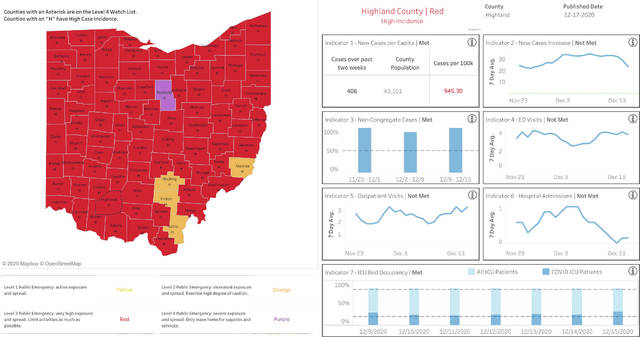
Ohio Gov. Mike DeWine announced that nursing home residents and staff members across the state began receiving COVID-19 vaccinations on Friday.
The Ohio Department of Health draft plan for vaccine distribution, which stated Covid vaccines will be distributed in three main phases:
In the first phase, the state and its partners will offer vaccines to high-risk health care workers, first responders, older adults living in congregate settings such as nursing homes, and those at significant risk due to underlying or comorbid conditions.
Ohio is currently in the first stage of vaccine distribution.
In the second phase, the state and its partners will offer vaccines to those working in fields essential to society, such as health care and human services operations, who are at critical risk and have a high risk of exposure; teachers and school staff; people of all ages with comorbid or underlying conditions; any older adults who were not included in the first phase; and people in homeless shelters, group homes and people in prisons, jails and detention centers.
In the third phase, the state and its partners will offer vaccines to young adults, children, and those who are working in industries and occupations important to the functioning of society and who have an increased risk of exposure.
Following these phases, the state will offer the COVID-19 vaccination to Ohioans who were not vaccinated in previous phases.
An update from the Highland County Health Department was not available as of press time.
On Wednesday, Highland County Health Commissioner Jared Warner reported that Highland County’s hospitalization rate remained steady.
“We had a decrease in hospitalizations last week, and then a rebound over the last couple of days,” Warner wrote. “We are waiting to see if we are leveling out or if our trend in hospitalization counts are going to continue upwards.”
Warner also reported that case counts had remained steady but were slowly “creeping upwards.” As of Wednesday, the health department had seen between 27 and 22 new cases each day over a seven-day period.
As of Wednesday, Warner said he expected that the Moderna Covid vaccine to arrive in the county around Tuesday, Dec. 22.
“Our initial shipment of 100 doses will be focused on EMS providers,” Warner reported. “Shipments are likely to remain very limited over the next few months and targeted to high-risk occupations and high-risk individuals. The vaccine is not available to the general public yet.”
Warner also addressed a question the health department received via Facebook last week regarding lower-than-average seasonal flu rates.
“I think it may be too early to tell what this year’s flu season will look like,” Warner said, “but it is quite possible that our season will be less serious than normal due to mask use, social distancing, and other precautions being taken. We are currently seeing flu cases lower than our five-year average would normally have us seeing this time of year.”
The following are Highland County’s overall COVID-19 statistics as of Wednesday:
Highland County has had a total of 1,699 lab-confirmed and probable COVID-19 cases, according to the Highland County Health Department.
The health department reported that there were 370 actively sick patients. The health department is monitoring 740 Highland County residents for symptoms, though the health department urges those who know they have had close contact with a confirmed COVID-19 case to begin quarantine independently.
Warner previously stated that the health department is no longer able to track the current number of patients hospitalized due to Covid. As of Friday, the Ohio Department of Health (ODH) reported 77 total hospitalizations due to COVID-19 in Highland County.
As of Thursday, Highland County remained a “red” county with high case incidence, according to the Ohio Public Health Advisory System (OPHAS).
“Red” counties, which OPHAS also classifies as level 3 public health emergencies, have “very high” COVID-19 exposure and spread.
In the past two weeks, Highland County has had 408 new cases, or 945.3 new cases per 100,000 residents, according to OPHAS.
Warner previously stated that the county must have under 100 new cases per 100,000 residents to decrease from a “red” rating.
Out of Ohio’s 88 counties, 83 counties were rated as “red” counties; four counties were rated as level 2 “orange” counties.
As of Thursday, one county was rated a “purple” level 4 public health emergency, which designates severe exposure and spread.
Last week, five counties were “purple.”
Residents in “purple” counties should only leave home for essential supplies and services, according to OPHAS.
No counties were rated as level 1 “yellow” counties, the lowest rate of exposure and spread.
According to the ODH, which reported 1,812 cumulative cases in the county as of Friday, of the cases in Highland County:
* 289 cases involved 50- to 59-year-olds. Of these cases, 11 resulted in hospitalization.
* 255 cases involved 40- to 49-year-olds. Of these cases, six resulted in hospitalization.
* 254 cases involved 30- to 39-year-olds. Of these cases, one resulted in hospitalization.
* 253 cases involved 60- to 69-year-olds. Of these cases, 15 resulted in hospitalization, and two resulted in death.
* 233 cases involved 20- to 29-year-olds. Of these cases, one resulted in hospitalization.
* 198 cases involved 70- to 79-year-olds. Of these cases, 25 resulted in hospitalization, and six resulted in death.
* 196 cases involved 0- to 19-year-olds. Of these cases, one resulted in hospitalization.
* 128 cases involved someone 80 years old or older. Of these cases, 17 resulted in hospitalization, and 10 resulted in death.
* Six cases involved patients of unknown ages.
Warner previously stated that there is a delay in the reporting process between individual counties and the ODH.
For more information on COVID-19 in Ohio, visit coronavirus.ohio.gov.
Reach McKenzie Caldwell at 937-402-2570.


